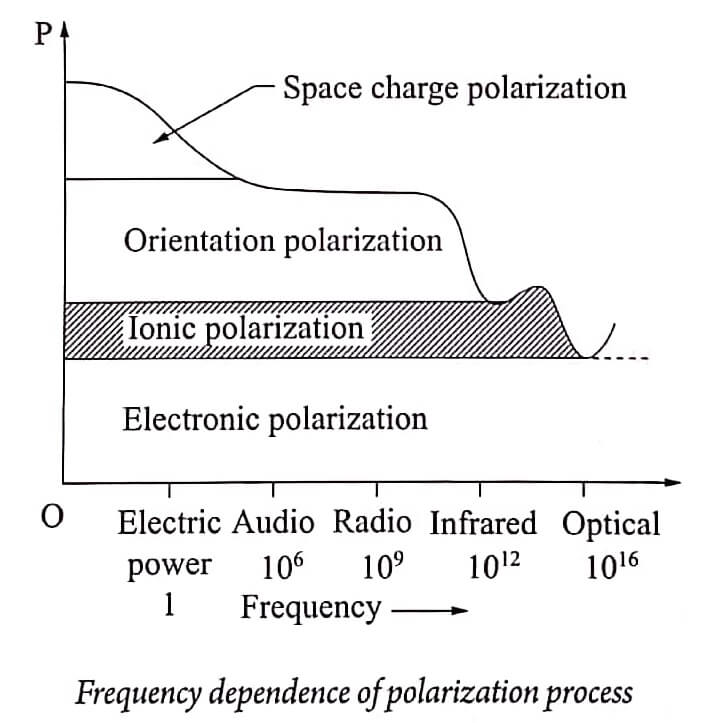When a dielectric material is subjected to an alternating field, the polarisation varies with time. The polarization p(t) as a function of time t is given by
P(t) = P[1- exp (-t/tr)]
where, P is the maximum polarization attained on prolonged application of a static field and tr is the relaxation time for the particular polarization process.
Relaxation Time: The relaxation time tr is a measure of time scale of a polarization process. It is the time taken for a polarization process to reach 0.63 of the maximum value. This varies widely for different polarization processes.
Frequency dependence
Electronic polarization is the fastest polarization.
- It will complete at the instant when the field is applied.
- The reason is that the electrons are very very light elementary particles than ions.
- This polarization occurs even at optical frequencies (∼1015 Hz)
Ionic polarization is slower than the electronic polarization.
- It is due to displacement of ions over a small distance due to the applied field.
- Since ions are heavier than electron cloud, the time taken for displacement is larger.
- If the frequency of the applied voltage is less than 1013 Hz the ions respond.
- Hence at 1013 Hz, we have both electronic polarization and ionic polarization responding.
Orientational polarization is lower than ionic polarisation.
- It occurs in polar molecules when an ac field is applied.
- It occurs between microwave and radio wave frequency (∼106Hz). In some materials it involves a limited rotation of molecules and occur even at low frequency.
Space charge polarization is the slowest process.
- This is because the ions diffuse over several interatomic distance.
- This process occurs at very low frequency in the order of 102 Hz.

Fig illustrates, all the four types of polarization at different frequency ranges.
- At optical frequencies (∼1015Hz) electronic polarization alone is present.
- At ∼1013Hz range ionic polarization occurs in addition to electronic polarization.
- At ∼106 to 1010 Hz range ionic polarization due to orientation polarization gets added.
- While at 102 Hz range space charge polarization also contributes.
At low frequency all four polarization occur and the total polarization is maximum. The total polarization decreases with increases in frequency and becomes minimum at optical frequency range.
Temperature dependence
The electronic and the ionic polarization do not depend on temperature. But the orientation polarization depends on temperature and space charge polarization depends strongly on temperature.
In orientation polarization, with the increase in temperature, the random motion of diploes increases and their orderly arrangement is decrease.
But, when the temperature of the dielectric material is decreased, the randomization of the motion of dipoles is also decreased and their orderly alignment under electric field increases.
Thus, the value of orientation polarisation increases with decrease in temperature.
In space charge polarization, the thermal energy facilitates the ion movement, it aids the molecules to align in the direction of the field. Hence, increase of temperature increases space charge polarization.
| Read More Topics |
| Polar and non-polar molecules |
| Classification of dielectric materials |
| Applications of superconducting materials |





